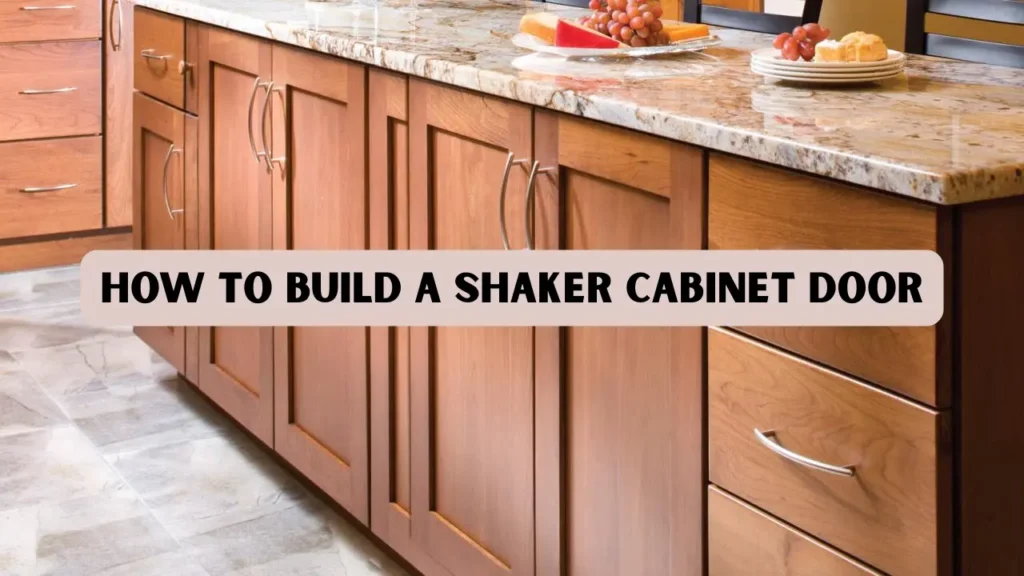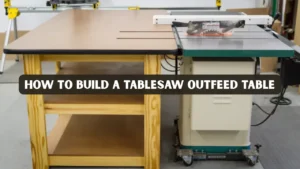Shaker-style furniture is admired worldwide for its simplicity, symmetry, and functionality. The cabinet door is one of its most iconic elements, defined by clean lines and a recessed center panel. Knowing how to build a shaker cabinet door is an essential woodworking skill that allows you to customize home interiors while practicing accuracy and craftsmanship.
Unlike ornate or heavily profiled doors, shaker doors highlight precision and material quality. They complement both modern and traditional spaces and remain a popular choice among DIY enthusiasts and professional woodworkers.
This article will guide you through every stage of the process, from design planning and material selection to joinery, assembly, and finishing. You’ll also find expert tips based on real woodworking experience to ensure your results look professional and last for years.
Key Takeaways
- Learning how to build a shaker cabinet door is an achievable woodworking project suitable for both beginners and experienced crafters.
- The core design uses a frame and panel construction that combines simplicity with durability.
- Proper measurements, correct joinery, and quality finishing define the professional look of a shaker door.
- With accessible materials and tools, anyone can create shaker-style doors for kitchens, wardrobes, or furniture pieces.
- This comprehensive guide provides expert instructions, real-world insights, and professional finishing tips for lasting results.
Why Build a Shaker Cabinet Door?
Building your own shaker cabinet door is more than just a cost-saving project, it’s an opportunity to create something personal, durable, and perfectly fitted to your space. DIY shaker doors allow you to choose the wood type, finish, and size that complement your kitchen or furniture design.
Benefits of Building Your Own Shaker Door:
- Customization: Choose dimensions, colors, and finishes that match your décor.
- Affordability: Save up to 50% compared to store-bought cabinet doors.
- Skill Development: Gain valuable woodworking experience in cutting, joining, and finishing.
- Sustainability: Use eco-friendly materials and reduce waste through precise measurements.
Whether you’re a seasoned woodworker or a beginner, crafting your own shaker cabinet door is a rewarding project that blends craftsmanship with creativity.
Materials and Tools Required
Building a shaker cabinet door involves minimal materials and a few key tools. Choosing the right wood and ensuring accurate cuts will define the quality of your final product.
Materials
- Hardwood or softwood for stiles and rails (commonly maple, poplar, oak, or pine)
- 1/4-inch or 1/2-inch panel (plywood, MDF, or solid wood)
- High-quality wood glue suitable for indoor use
- Wood filler and sandpaper (120 to 220 grit)
- Primer, paint, or stain with clear finish
- Hinges, screws, and handles (optional)
Tools
- Table saw or circular saw
- Router with stile and rail bit set
- Router table or dado stack for grooves
- Clamps for gluing
- Measuring tape and square
- Drill and driver bits
- Brushes or spray gun for finishing
Designing and Measuring the Door
Accurate measurement is crucial when learning how to build a shaker cabinet door. Start by determining the exact opening size of the cabinet. Add overlay if your doors will sit on top of the frame, or subtract clearance if you are making inset doors.
Design checklist:
- Stile and Rail Width: Typically 2 to 2.5 inches wide.
- Door Thickness: Standard 3/4 inch.
- Panel Allowance: Leave a 1/8 inch gap on each side of the panel inside the groove for expansion.
- Overlay/Inlay: Adjust the door size depending on hinge style and overlay preference.
Always create a detailed cut list before you begin cutting. It prevents errors and ensures that all pieces are consistent.
Expert Advice:
Consistency in width and thickness across stiles and rails ensures the door remains square during assembly. Use a thickness planer if necessary to match dimensions perfectly.
How to Build a Shaker Cabinet Door Step-by-Step
Building the door involves a series of carefully executed steps. Precision and patience are essential throughout the process.
Step 1: Cut the Frame Components
Cut your stiles and rails to exact dimensions based on your design plan. Use a crosscut sled or miter gauge to ensure clean, square cuts. Label each piece (for example, S1, S2, R1, R2) to maintain order.
Tips for accuracy:
- Use a stop block for repeat cuts.
- Double-check measurements before cutting each piece.
- Always measure twice and cut once.
Step 2: Cut Grooves for the Panel
Using a router or dado blade, cut a centered groove in all stiles and rails. The groove should be wide enough to accommodate the panel’s thickness and about 1/4 inch deep.
Quick tip: Make test cuts on scrap wood to verify the fit before cutting the actual pieces.
Step 3: Create the Joinery
There are several joinery options, each with its own advantages:
- Cope and Stick: A matched router bit set creates a decorative yet strong joint.
- Mortise and Tenon: The traditional method for maximum strength, ideal for solid wood doors.
- Biscuits or Splines: Suitable for quick builds when precision tools are limited.
Choose the method that fits your tools and skill level. For painted doors, cope and stick is efficient and reliable.
Hands-on Experience: Professional cabinet makers often use cope and stick joinery because it balances strength with production speed.
Step 4: Prepare the Panel
Cut the center panel slightly smaller than the opening to allow for movement. If using MDF or plywood, the panel can be glued in place. For solid wood, keep it floating inside the groove to prevent cracking due to seasonal expansion.
Panel material tips:
- MDF panels are ideal for painted finishes.
- Solid wood panels enhance natural grain aesthetics.
- Plywood offers stability and cost-effectiveness.
Step 5: Dry Fit the Assembly
Before gluing, assemble the entire door without adhesive to ensure a perfect fit. Check for gaps, alignment, and squareness by measuring diagonals. Adjust as needed until the frame fits seamlessly.
Step 6: Glue and Clamp
Apply wood glue to the joints only, not to the panel (unless it is MDF). Assemble the frame, insert the panel, and tighten clamps gradually. Ensure even pressure from all sides.
Clamping checklist:
- Alternate clamp directions to prevent twisting.
- Check diagonals again to confirm squareness.
- Wipe away excess glue immediately.
Step 7: Sanding and Finishing
Once the glue has dried, remove clamps and sand the entire door starting with 120 grit and progressing to 220 grit. Fill any small imperfections with wood filler.
Finishing steps:
- For painted doors: Apply primer, sand lightly, then apply two topcoats.
- For stained doors: Apply wood conditioner, stain, and two coats of clear finish.
Pro Tip: Spray finishing provides the smoothest result, especially on MDF panels.
Case Study: DIY Homeowner Builds Shaker Cabinet Doors
- Emily, a beginner woodworker from Oregon, learned how to build a shaker cabinet door using poplar and MDF, completing six doors over a weekend for under $150 that still function perfectly two years later.
- Michael, an experienced DIYer from Texas, built four oak shaker doors for his home office in two weekends, achieving a professional, durable finish that enhanced both functionality and aesthetics.
Expert Tips and Real-World Insights
Based on years of woodworking practice, several professional habits can elevate the quality of your doors.
- Always test your router setup on scrap pieces.
- Use biscuits even in mortise and tenon joints to aid alignment.
- Maintain consistent grain direction on all visible faces.
- When making multiple doors, create a jig or stop system for repeat accuracy.
- Store finished doors flat to prevent warping.
Professionals with decades of cabinetry experience agree that attention to detail during glue-up and finishing determines the final quality more than any single tool.
Cost, Time, and Material Considerations
Building shaker cabinet doors is affordable compared to purchasing pre-made ones.
Approximate cost per door:
- Poplar and MDF: $20–$35
- Hardwood (oak or maple): $40–$60
Time requirement:
- Beginners: 3 to 4 hours per door
- Experienced builders: 1 to 2 hours per door
Savings and value:
Custom-built doors often match or exceed commercial quality at half the price. They also allow for custom sizing and finishes unavailable in mass-produced options.
Common Mistakes and How to Avoid Them
Avoiding common errors ensures your project succeeds.
Frequent mistakes:
- Gluing solid wood panels into grooves (causes splits).
- Inconsistent measurements leading to unsquare frames.
- Using dull router bits that burn or tear wood fibers.
- Skipping the dry-fit step.
- Forgetting to leave expansion space for panels.
Troubleshooting tips:
If the door twists or bows, check for uneven clamping or moisture imbalance. Allow wood to acclimate to your workshop environment before cutting.
Maintaining Shaker Cabinet Doors
Proper care extends the life and look of your doors.
- Clean using a soft cloth and mild detergent.
- Avoid harsh abrasives or excessive moisture.
- Repaint or refinish when the surface dulls.
- Check hinge screws annually to prevent sagging.
Well-maintained shaker doors can last for decades, retaining their original beauty and functionality.
Conclusion
Learning how to build a shaker cabinet door empowers you to create professional-quality cabinetry that combines beauty and durability. With accurate measurements, proper joinery, and attention to finishing, you can produce doors that rival any store-bought version.
This project not only enhances your woodworking skills but also brings a sense of craftsmanship and pride to your home. Whether you are upgrading a kitchen or building custom furniture, shaker doors are a timeless choice that never goes out of style.
By following the detailed steps, expert tips, and maintenance guidance shared here, you will be ready to take on future cabinetry projects with confidence and precision.
FAQs
What wood is best for painted shaker doors?
Poplar or MDF is recommended because both have smooth surfaces and resist warping under paint. They are also affordable and easy to machine.
Can I build shaker doors without a router?
Yes. A table saw with a dado blade can cut the grooves and tongues needed for the frame and panel design. However, a router provides cleaner results and more flexibility.
How much clearance should I leave around the door?
Leave approximately 1/8 inch gap on each side for inset doors or follow hinge manufacturer recommendations for overlay types.
Can I use plywood for the entire door?
Yes, but it changes the look slightly. A frame-and-panel shaker design provides better visual depth and traditional styling.
How long will it take to master shaker door construction?
After building two or three doors, most woodworkers develop consistency in measurements and clamping, which results in professional-grade outcomes.




